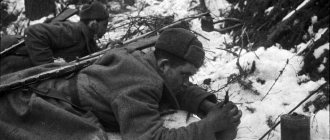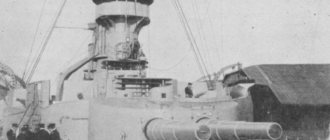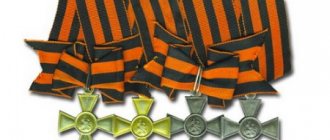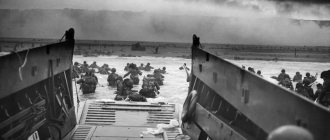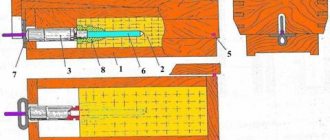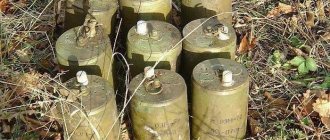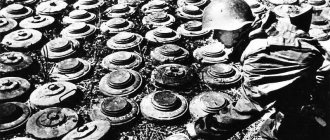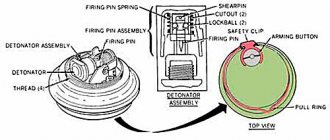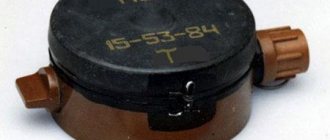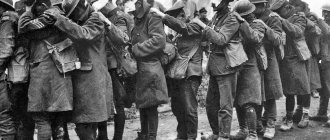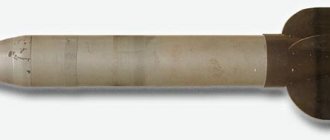Mines in the World War 1914–1918.
Mines in the World War 1914–1918.
The Russian army was technically ready for mine warfare, but not in terms of the volume of reserves of explosives and blasting equipment. Suffice it to say that the wartime report card for the engineering equipment of the Russian sapper battalion of the army corps included only 284 kg of pyroxylin, 200 fuses and 800 detonator caps. Central reserves were made for no more than 6 months of hostilities.
Author's note
However, all European armies were not ready for a long, intense war with enormous expenditure of ammunition. In many ways, it was the rapid depletion of peacetime reserves that led to the positional deadlock. Having emptied their arsenals during the 3-4 months of the war, the armies were forced to consolidate their positions on the achieved lines while waiting for industry to develop and be able to provide the troops with ammunition and equipment. During this time, the infantry, which had already experienced deadly machine gun fire and shrapnel explosions in the open field, dug in so firmly that breaking through the defense became an extremely difficult and very bloody affair.
All stocks of explosives, fuses and primers were used up in the first 2-3 months, when sappers covering the withdrawal of the Russian army from Poland, East Prussia and Bukovina had to blow up bridges and place land mines on the roads.
Since the German army had neither mine detection equipment nor mine clearance specialists, even single land mines greatly hindered the advance of the Kaiser's troops, and in some cases stopped them. The Germans preferred to wait until their sapper units had built new roads bypassing the existing ones.
According to Russian nomenclature, landmines (the term “mine” at that time was used only in relation to sea mines) were divided as follows.
By area of application: 1) field; 2) serfs; 3) river.
According to technical characteristics: 1) ordinary mines (exploded from a control point, i.e., in modern language, guided mines); 2) self-explosive (today these are ordinary unguided mines); 3) repeated (training and training-imitation).
Tactical and technical requirements for high-explosive barriers were established. Land mines were prescribed to cover “dead” spaces that were not hit by cannon and machine gun fire. The landmines should have been installed in 2-3 lines, in groups of 5-15 charges, with a distance of 8-12 meters between them, and 20-30 meters between the lines.
Already at the beginning of 1915, the army began to receive factory-made land mines, which were a modification of the Karasev mine.
They were called "large shrapnel landmine" and "small shrapnel landmine".
Factory-made landmine (modification of the Karasev mine)
Unfortunately, their descriptions have not survived. Basically, these landmines were filled with black powder, which the artillery abandoned in 1905, but which had significant reserves in Russian warehouses.
Demolition machine mod. 1913 and Dreyer electric igniter arr. 1874
The landmines were detonated by an electrical impulse from the control panel. The land mines were buried in the ground in no man's land, in front of the wire fences, at a distance of about 200 meters from the trenches.
The PM-13 blasting machine, created in 1913, was used as a control panel. It developed a voltage of 60 volts with a current strength of 0.7 amperes and could detonate up to 7 spark electric igniters of the Dreyer system of the 1874 model, connected in parallel. The electric pulse was transmitted through a 1900 model sapper wire. 1 kilometer of this wire had a resistance of only 4 ohms.
In addition to Dreyer fuses, the sappers had electric fuses of the 1905 model, with a platinum bridge.
To construct electric explosive networks for shrapnel land mines, sappers had a so-called “contact board”, which ensured the distribution of current among the charges, and to check the network they had an ohmmeter of the 1913 model.
During the war, on their own initiative, officers and soldiers of sapper units invented, manufactured and widely used very original mines, which could be classified as anti-barrier mines (if such a group existed). These are not even mines, but means of making passages in barriers.
The fact is that when in 1915 the war acquired a positional character, the opposing armies began to cover their positions with continuous barbed wire barriers. It is impossible to overcome such dense barriers without first destroying them. Meanwhile, to make one passage 5-10 meters wide it was necessary to spend from 150 to 250 artillery shells. And it was also not possible to manually make passages under machine-gun fire. Therefore, sappers have developed many samples of extended explosive charges for destroying wire fences.
Some of them were extended manually, others were self-propelled. The mine-charge of non-commissioned officer Semenov, the trolley device of private Savelyev, the mobile mine of Sidelnikov, the creeping mines of Kanushkin and Doroshin, the crocodile mine of Colonel Tolkushin are known.
Unfortunately, no information has been preserved about these mines, although even in the orders on offensives of the front commanders, the use of such mines was specifically stipulated.
The First World War did not contribute to the development of mine weapons as a tactical weapon for a long time. The battlefield was dominated by guns and machine guns, reliably destroying the infantry slowly making its way through the terrain pitted with craters and blocked by wire barriers. The attacking infantry battalion was destroyed by artillery and machine guns in 5–7 minutes! There was no place for cavalry on such fields at all. So there was no particular need for anti-personnel mines, and everyone quickly abandoned mining the wire fences in front of their front line.
Crocodile mine designed by Colonel Tolkushin (photo taken in the 1920s)
Perhaps only mining during the withdrawal of troops to their original positions after capturing enemy positions, if he counterattacked with superior forces, could be classified as a tactical method of battle. Then trenches, dugouts and other structures were mined with pressure mines and booby traps in order to make it difficult for the enemy to use his own trenches and defensive structures.
Or mines were used to cover the general withdrawal of troops, which most often occurred in the final phase of the war. Thus, after the successful battle of Cambrai (June 5–7, 1918), the Allies were unable to pursue the hastily retreating Germans due to mines, and the German commanders turned the flight into a systematic retreat.
The Germans took the lessons of the Russo-Japanese War quite carefully. Although they did not study the experience of mine warfare enough, by the beginning of the First World War the German army adopted a self-exploding mine called “Tretmine”, equipped with dynamite.
The books of the famous Soviet mine specialist Colonel I. G. Starinov (1899–2000) indicate that the Germans were the first to use systematic mining on a mass scale to cover their withdrawal from France to the so-called “Siegfried Line” in March 1916. However, from the memoirs of General Erich von Ludendorff it follows that in reality the Germans developed and implemented the Alberich plan. This plan provided for the evacuation of troops from the French arc to pre-prepared Siegfried positions. This plan provided for the massive destruction of roads, bridges, buildings and structures in a strip of up to 15 km in front of defensive positions, as well as the removal of all property suitable for use by the enemy. Ludendorff does not mention mining even in passing. It seems that Starinov was wishful thinking.
The fact is that there were no specially designed anti-personnel mines then. Conventional artillery shells were used as mines, in which the artillery fuse was replaced with a special pressure-action fuse, which had the same (or almost the same) appearance as a regular shell fuse. These shells were usually buried in the bottom of a trench, in the floor of a defensive structure, or in the roadbed.
The Germans, in addition, used delayed fuses, which exploded the shell within 48 hours after detonation. These shells were impossible to find because they were buried in such a way that they were not visible. In a number of cases, such mining led to the refusal of French and British soldiers to return to their trenches.
However, mines have found quite widespread use in another capacity, namely as a soldier’s means of revenge for dead comrades, a way to throw out accumulated irritation, fatigue, express hatred of enemy soldiers, even a kind of entertainment, cynical soldier humor. This is what one of the German officers wrote in those days:
“People in the trenches spend whole days turning every dugout into a death trap and the most innocent things become hellish machines. Some dugouts fly into the air when the doors are opened. A drawing table with several books lying on it is a trap, and from each book there is an electrical wire leading to a charge capable of destroying a platoon. A gramophone left on the table and playing a record is also a trap and it will explode when the melody ends. Scattered piles of cans of beef stew became diabolical missiles of doom. Hundreds of tension mines are placed in front of the trenches. ...Indeed, I never thought that the British Tommy had such diabolical ingenuity.”
M. Kroll writes that the use of mines (and other means) for the purpose of causing losses to the enemy, regardless of the solution of tactical problems and purely military necessity in general, is very characteristic of the First World War, which he rightly calls a grandiose massacre.
A significant event in the development of mine weapons was the breakthrough of German positions on the Somme River on September 15, 1916 by 32 British tanks. The success was amazing: the German front was broken through 5 km wide and 40 km deep! There was nothing to oppose the new weapon. Machine guns were powerless against armor, conventional field guns could not effectively fight tanks, and it took time to develop special anti-tank guns with a high initial projectile velocity.
German improvised anti-tank mine made from an artillery shell
The only means capable of stopping the tanks were mines. At first, the Germans did it simply: they buried artillery shells vertically in the ground, the fuses of which remained above the surface of the earth. They became the first anti-tank mines. The Germans then improvised many types of mines, including a wooden box mine that measured approximately 36? 41? 5 cm and weighed about 5.5 kg. Twenty 200-gram B bombs (4 kg) were placed in a box, which was buried to a depth of 25–26 cm. The explosion was initiated by a hand grenade placed at one of the walls of the box so that the detonating cord passed through a hole in the wall of the box to the outside. The mines exploded when pressed by the tank's track or from the control panel.
However, anti-tank mines, improvised from shells or made in front-line conditions, were very unreliable and dangerous to use. Therefore, the Germans urgently developed and put into industrial production a standard anti-tank mine. It consisted of a tarred wooden box measuring 33? 23? 15 cm. The charge consisted of 3.6 kg of pyroxylin. A spring-supported bar across the top cover of the mine fell down under the pressure of the tank track, causing the fuse to fire.
The method of installing mines in front of a wire fence two meters away from it towards the enemy was also used. A wire was tied to every third fence post, leading to a box of explosives buried two meters from the fence. When a moving English tank knocked over a fence post, the explosive charge exploded under the bottom of the tank, destroying the vehicle and crew. This simplest mine should be considered the first anti-tank anti-bottom mine.
Although the result of the first tank attack on September 15, 1916 was ultimately modest, and the tanks achieved real success only during the Battle of Cambrai in November 1917, the Germans were very prudent, starting factory production of anti-tank mines in December 1916. By the end of the war, they produced almost 3 million of them. It is unfortunate that information regarding the design details of these industrially produced mines has not been preserved.
After the war, the Germans calculated that the losses of Allied tanks from mines were significant. Thus, the British lost 15–28% of their tanks to mines during the battles of Saint-Michel, Catale-Bonny, Sel and Meuse/Argonne. The famous German theorist and practitioner of the use of tank forces, General Heinz Guderian, in his book “Attention, Tanks!” (written in 1937) indicated that only from the end of July to mid-November 1918 (in 3.5 months) the French lost 87 tanks to mines.
The Germans were the first to come to the conclusion that mines could bring success if two mandatory conditions were met:
1. Mines should be laid in several long rows; Individually placed mines or small groups of mines are ineffective.
2. The minefield must be covered with machine gun fire and artillery; machine guns will eliminate the evacuation of the crew of a damaged tank and will not allow organizing towing of the tank to the rear; artillery finishes off a damaged tank.
The Germans also developed the first standard for an anti-tank minefield: 2 meters between mines, 2 meters between rows of mines, 2-3 rows of mines.
The successes of German mine weapons forced the Allies to acquire means of overcoming minefields. In 1918, the British created a minesweeper tank based on the Mark V tank. He pushed in front of him several heavy rollers, each 60 cm in diameter, strung on a single axle, the lever from which was attached at the other end to the tank body.
This trawl was developed by the Mechanical Field Company (Royal Engineer). The existence of a minesweeper tank among the British is mentioned in their works by Guderian and another famous German tank theorist L. R. von Eymansberger.
The Allies, believing that the appearance of German tanks would not be long in coming, also took measures to develop anti-tank mines. The British released three samples of mines: the first was in the form of a piece of pipe, the second was from an artillery shell, and the third was a box mine. The latest model was developed at the beginning of 1918 by the experimental department of the Corps of Royal Engineers.
It was a wooden box measuring 46? 36? 20 cm containing 6.35 kg of pyroxylin. The mine was initiated by lowering a hinged cover that used a pressure lever linked to a detonator.
Anti-tank anti-track pressure mines (1918); left
-
English; on the right is German.
The thin rod sticking up is the safety pin that was pulled out of the mine after installation.
In a German mine, the target sensor is a horizontally located metal rod, supported by two metal gusset triangles and held in a raised position by springs
It should be noted that the trigger force of both German and British mines from the First World War period did not exceed 45–50 kg, so sometimes they could be triggered by stepping on them. Such isolated cases later gave rise to the erroneous thesis among military historians that anti-personnel mines originally appeared as a means of protecting anti-tank mines. It is easy to see that this thesis is wrong by recalling at least the period of the American Civil War. That is, anti-personnel pressure mines were used more than 50 years before the first tank appeared on the battlefield.
On March 22, 1918, German tanks advancing on Gozencourt stumbled upon a British minefield and lost a couple of vehicles, after which the crews refused to move on. But anti-tank mines had their greatest success in March 1918, when 35 Mark Vs tanks of the American 301st Heavy Battalion stumbled upon the same minefield that everyone had forgotten about. The Americans lost 10 tanks to mines in this attack. In this case, the English mines were mortar mines, reinforced with 23 kg of ammotol (ammonite) each. They pierced the thin bottom of the vehicles and destroyed the crew.
The Allies promptly warned Russia about the possibility of the Germans using tanks on the Eastern Front. Under their influence, Russia urgently developed several samples of anti-tank mines and set up their factory production. Russian mines turned out to be more advanced than English mines. All of them were of the self-explosive type. The mine designed by Revensky was anti-track, with a pressure-action fuse. The mines of Dragomirov and Salyaev had an inclined fuse and exploded both under the tracks and under the hull of the tank, destroying the crew and the vehicle. However, German tanks never appeared on the Russian front.
The author was unable to find documentary information about the use of object mines in the First World War, although numerous secondary sources indicate very active sabotage activities of German agents to disable military and industrial facilities in a number of countries, including Russia. Thus, according to information given in the book of Colonel A.I. Ivolgin, a number of accidents at Caucasian oil industry enterprises, which belonged to German citizens before the war, were organized by their agents.
In particular, explosions and fires occurred at Maikop oil wells, an oil pipeline from Maikop to the Black Sea exploded, and upon inspection, obvious traces of explosives were discovered.
In July 1916, Swedish police arrested a group of German citizens led by Baron Otto von Rosen who were heading to Russia. During the search, dynamite and delayed-action chemical fuses were found in their possession.
In the same month, in the port of Trondheim (Norway), an explosion and fire occurred in the warehouses of the company Baske and Iverson, where cargo intended for shipment to Russia was stored.
The transport ship Baron Driesen exploded in the Arkhangelsk port. During the war years, 15 explosions and fires occurred in military warehouses in Vladivostok.
Strange are the circumstances of the explosion of the steamer "Urania" in the throat of the White Sea, which was carrying gunpowder and pyroxylin from the United States. The captain of the steamship "Nonny", who was following the "Urania", testified during the investigation that he lifted all the crew members of the "Urania" from the boats onto board his ship. The sailors had all their personal belongings and money with them. And soon there was a grand explosion at the Murmansk explosives warehouse.
All these disasters could be attributed to ordinary Russian sloppiness and the desire of suppliers to hide grandiose thefts, but here is the testimony of a French officer on the Western Front:
German sabotage chemical delayed action fuze
“At the end of October 1918 we encountered systematic destruction; Time bombs appeared in the areas of Le Havre and Roy. According to the register handed over to us by the German side at the conclusion of the armistice, the installation of mines began on August 15, and the timing of the explosions was determined at 4 weeks.”
The officer further writes that, in fact, explosions on the railway between Lille and Lyon continued until March 1919. Some mines contained up to 9 tons of explosives.
He also provided a drawing of a German delayed-action fuse. Consequently, the use of object mines by the Germans against Russia, which exploded after a certain period of time, cannot be ruled out, although there is no reliable information about this.
Answers to AiF crossword number 3
Horizontal:
- 1. Which has the most shapes? [10 letter answer: A?????????I]
Vertical: AiF 2
Horizontal:
- 5. “Intriguing hole” on the skirt from 6 letters
- 9. Philological action of 6 letters
- 10. What does the heroine of the drama “The Barber of Siberia” eat with champagne?
- 11. Which of the Potter characters had a scar above his left knee in the shape of an 8-letter map of the London Underground?
- 14. The original territory is ready from 11 letters
- 16. “Silent BIRTH
” by Scientologists with 4 letters - 18. Wheat fruit from 5 letters
- 19. Immaculate celestial from 5 letters
- 20. “Dining repertoire” of 4 letters
- 23. “Opening” of Pandora from 4 letters
- 28. “Tormentor of governors” by Alexander Pushkin from 8 letters
- 29. Which literary device was the first to use by Las Hermione using 10 letters?
- 30. The worst enemies of hobbits from 4 letters
- 31. What sparkles so much in the story “Passenger” by Mikhail Zoshchenko from 8 letters
- 32. Ensign in a naval jacket made of 6 letters
- 33. Why does a businessman get profit from 5 letters?
- 34. What does the guard give out of 4 letters?
- 40. “One name for all” local residents of 7 letters
- 42. “It’s easy to write poetry, but it’s difficult to be a poet” (Russian critic) from 9 letters
- 43. Compact crossover with a 4-letter Ford logo
- 44. “Cardboard sketch” of 5 letters
- 45. Lake from the poem “Friend’s Rose” by Eduard Asadov, 5 letters
- 46. On what mountain did the 7-letter muses live?
- 47. Which Hollywood star “trusts exclusively the Stanislavsky method” from 4 letters
- 48. Accounting judge from 7 letters
- 49. Pathos-sounding speaker with 5 letters
- 50. 5 letter arts and crafts
- 51. Check scales
on the market from 4 letters - 52. Legendary actress Judy Garland
joked that she was born at the age of twelve on the set of the Metro-Goldwyn-Mayer film studio.
Vertically:
- 1. “Overture” to withdrawing money from an ATM with 11 letters
- 2. Piece of grapes from 5 letters
- 3. The doctrine of the power of medicines from 15 letters
- 4. 7-letter bowling alley fun
- 6. Archer with 4 letter wings
- 7. The face of a boar with 4 letters
- 8. “Funeral dance” among the Chechens with 4 letters
- 10. “Meteor” for racing drivers has 5 letters
- 12. Writer at the head of Czechoslovakia from 5 letters
- 13. “Measure LIFE
by experience, not by years” from 5 letters - 15. Magic book from the Middle Ages from 7 letters
- 17. Who does the writer Dmitry Bykov consider to be the “only Gothic writer” of the Silver Age from 7 letters
- 18. Where to look while shaving from 7 letters
- 21. Which Russian showman has 5-letter Donetsk roots?
- 22. “How my living CONNECTION
” from 5 letters - 24. The only non-swimmer in history to win six gold medals at one 5-letter Olympic Games
- 25. Whose painting “The Kiss” is mentioned in the 5-letter novel “Inferno” by Dan Brown
- 26. “Make an IMPRESSION
” of 11 letters - 27. “ SMOOTHING
sharp corners” in 11-letter side relations - 31. “Cradle” of Shar-Peis from 5 letters
- 34. Which Russian artist is considered by art historians to be the “author of one picture,” although he painted them in a variety of 7 letters?
- 35. 7 letter Persian battle ax
- 36. Where do they live from 3 letters
- 37. How to embroider 5 letters
- 38. Anti-fever tablets with 7 letters
- 39. Who helps others enjoy 7 letter bad habits
- 41. “Landscape nature” from 6 letters
- 42. A stone that gives relief from colds and runny nose from 6 letters
- 46. Blacksmith's hearth from 4 letters
Cat [3 days ago] Answers to crossword puzzle AiF 3 2022
